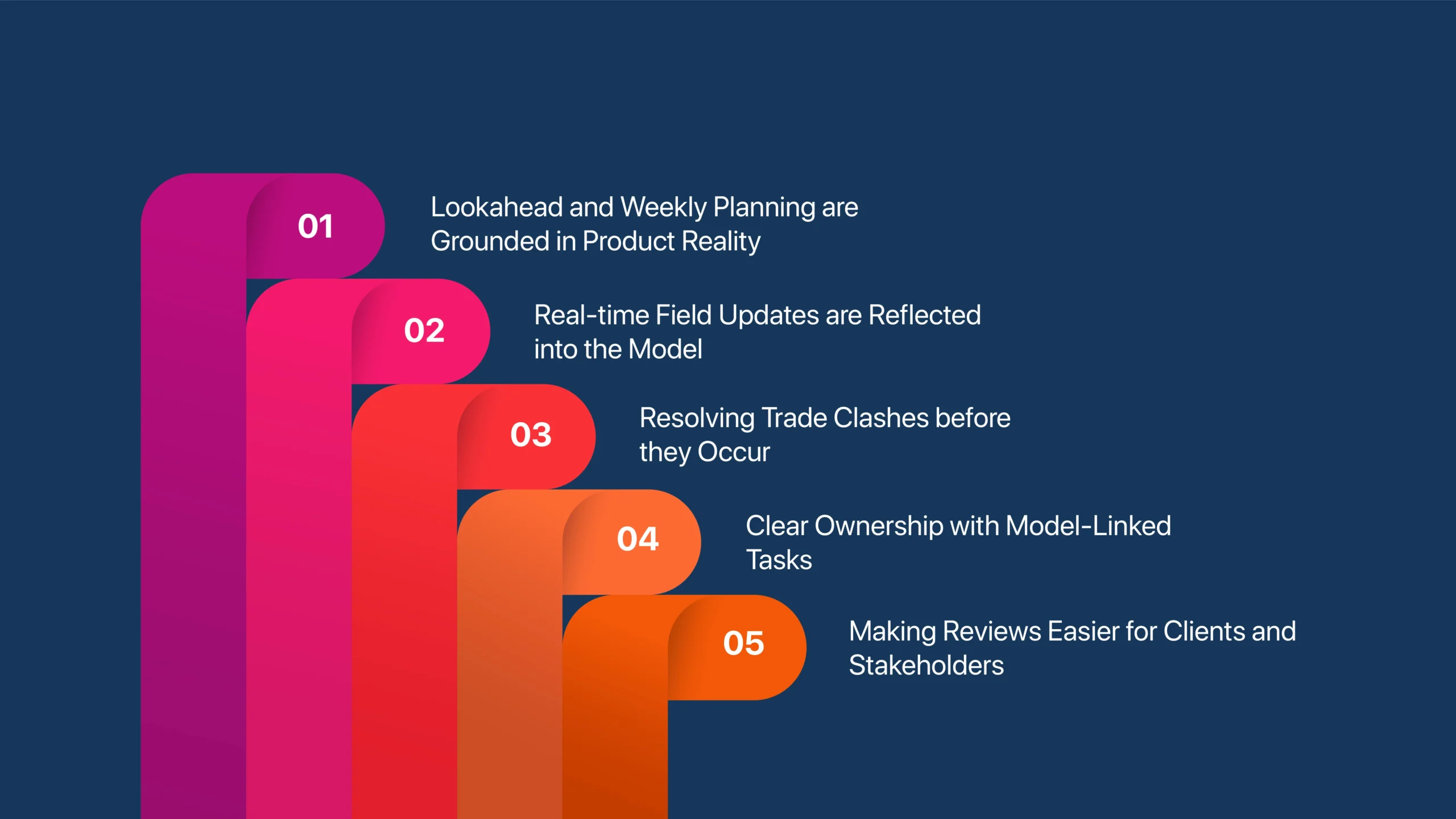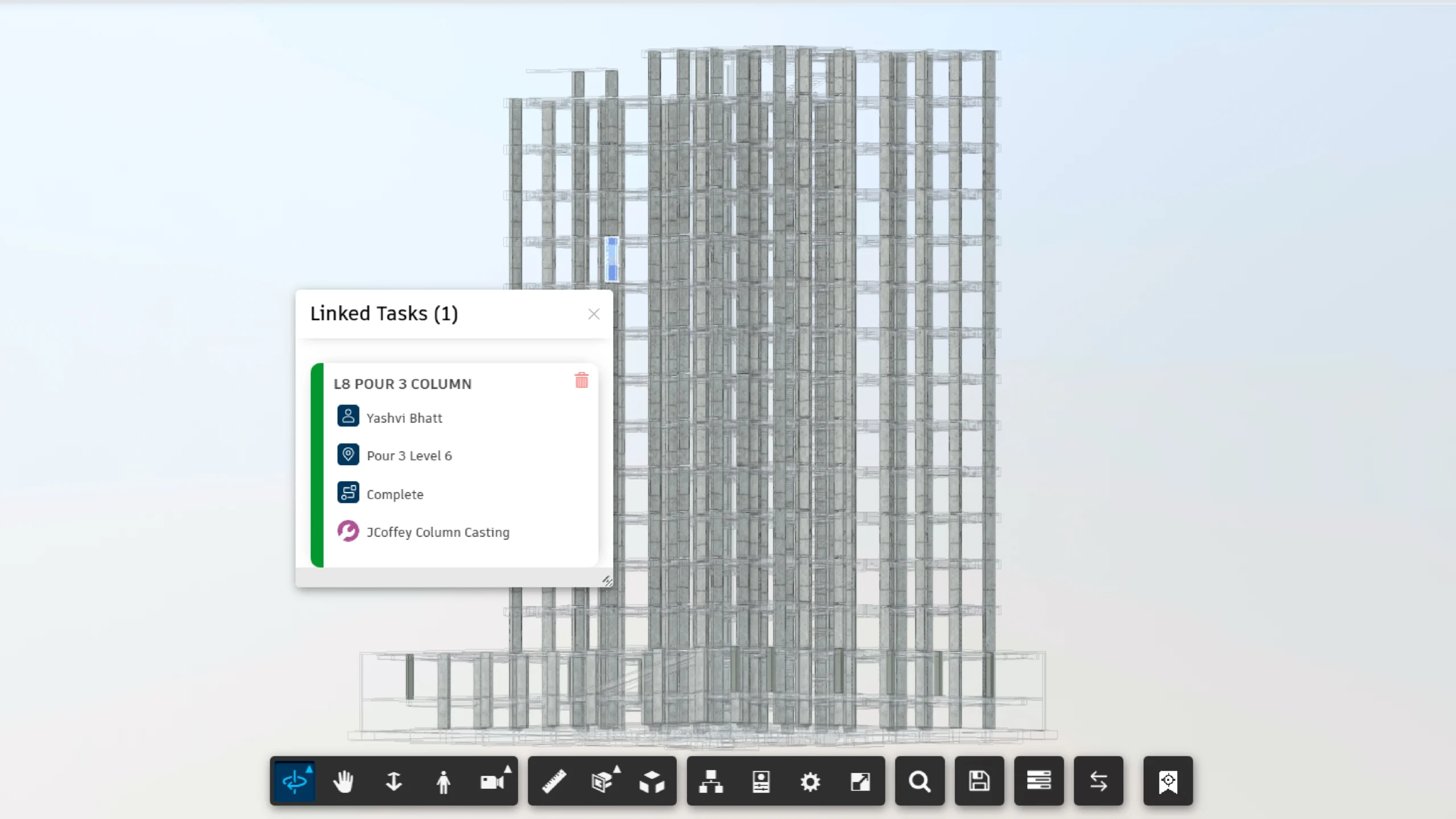How BIM in VisiLean goes beyond visualisation — bringing the model to life and embedding it at the heart of project delivery.
Why BIM Alone isn’t Enough?
Building Information Modelling (BIM) has transformed how construction projects are planned, providing a precise, data-rich digital representation of a building before a single brick is laid. Yet, in most projects today, BIM remains largely confined to the design and preconstruction stages. Once work begins on site, it often becomes a static reference point — something revisited occasionally for clarification but not actively driving day-to-day execution.
The real opportunity lies in extending BIM’s role beyond design coordination into live production control. This means using the model not only to visualise the end product, but to monitor progress, update task status, and guide on-site decision-making in real time.
VisiLean makes this possible by connecting every scheduled task to its corresponding BIM element, transforming the model from a passive design file into an active project control tool. And when combined with Lean workflows, it enables a smarter and more connected construction process where design intent flows seamlessly into execution.
This blog explores how BIM in VisiLean goes beyond visualisation — bringing the model to life and embedding it at the heart of project delivery.
VisiLean Connects Product with Process through 4D BIM
Lean construction recognises visual management as a powerful way to build a shared understanding among all project participants. When everyone can clearly see the plan, progress, and potential issues, project reviews become more meaningful — leading to more effective control over delivery. In VisiLean, BIM enhances, not replaces, the Lean planning workflow. Rather than treating BIM as a passive design file, VisiLean integrates it directly with Collaborative Planning. Here’s how;
Lookahead and Weekly Planning are Grounded in Product Reality
When the tasks are directly connected with the physical elements of the model, it allows teams to build short-term plans with a clear understanding of what exactly needs to be built, where it sits in the project and what conditions affect its readiness.
This helps planners to assess site readiness quickly — if work areas are available, if prior activities are complete, and if there are any unresolved constraints that might affect progress. All of this is visible within the model, making it easier to coordinate between teams, plan sequences more accurately, and avoid last-minute disruptions.
Moreover, when teams commit tasks in the Weekly Work Plan, they’re doing so with clarity on what’s actually buildable on site. This improves the quality of planning conversations and directly contributes to a higher Percentage Plan Complete (PPC) — because plans are not based on assumptions, but on verified readiness.
Real-time Field Updates are Reflected into the Model
As site teams update progress in VisiLean, the changes are instantly reflected in the model through the Planned vs Actual view. This gives a clear, real-time comparison between what was scheduled and what’s happening on site.
Each task-linked component is colour-coded based on its status — Not Started, In Progress, Completed, or Blocked. This makes it easy to see how work is progressing across different areas of the project. If something is delayed or held up, it’s immediately visible in the model, helping teams respond faster and adjust plans accordingly.
Since these updates come directly from the field, the model stays aligned with real conditions on site, without waiting for manual reports or status meetings.
Resolving Trade Clashes before they Occur
Trade coordination issues are one of the most common and costly sources of disruption in construction projects. When teams work within tight spaces, even a minor misalignment can trigger rework, delays, and disputes on-site. These clashes are often not discovered until installation begins, by which point the cost of correction is far higher.
Through VisiLean, these risks are significantly reduced by bringing the model into the centre of the planning and execution process. Each task is directly linked to specific components in the BIM model, allowing planners, coordinators, and trade leads to see their scope visually — and in relation to other ongoing or upcoming work. Instead of interpreting scope from line items in a schedule, teams can navigate the model, understand the spatial context, and identify potential overlaps between systems before work is released to the site.
More importantly, this level of visibility helps create informed discussions during lookahead planning sessions. If two trades are scheduled to work in the same zone during the same week, the conflict becomes immediately obvious within the model.
Clear Ownership with Model-Linked Tasks
When tasks in VisiLean are connected to specific components in the model, the scope becomes clear for everyone — from planners to the site crew. In the screenshot attached below, the model highlights a column, and the linked task displays exactly who’s responsible, what level it belongs to, and what needs to be done. There’s no ambiguity about what “L8 Pour 3 Column” refers to — you can see it, click on it, and track it in real time.
This makes the process more transparent. You know the person assigned, the location of the work, and the status — if it’s started, completed, or facing issues. Updates from the field instantly reflect in the model, so if there’s a delay or change, it’s visible to everyone involved. You don’t need to chase down reports or double-check which task someone’s referring to. It’s all in the model, tied directly to the real structure.
This level of clarity keeps teams aligned. It reduces back-and-forth questions, avoids scope overlap, and makes it easier for people to take ownership of the work they’re responsible for — because it’s right there in front of them.
Making Reviews Easier for Clients and Stakeholders
Progress reviews and approvals can often become time-consuming when everyone’s working with different tools or information. VisiLean makes this easier by giving stakeholders access to a single model environment that reflects live updates from the site. Tasks show up on the model based on their real progress, so whether something is completed or blocked, it’s clear from a quick visual check.
Clients and consultants don’t need to ask for separate reports or status summaries — they can open the model, look at the relevant area, and see exactly what’s going on. Each task can include photos, documents, and checklists, all connected to the part of the project it belongs to. This helps close feedback loops faster, speeds up inspections and approvals, and reduces unnecessary coordination overhead.
VisiLean Makes BIM More Actionable in Your Projects
BIM has always held the potential to transform how construction projects are delivered — but only when it’s connected to the day-to-day reality of project execution. VisiLean makes that connection possible. By integrating BIM directly with Lean workflows, teams can plan with real components, track progress against live updates, and identify issues early — all in one shared model environment.
This isn’t about using BIM as a design reference or a visual aid. It’s about using it as the actual interface for construction planning, monitoring, and control. From creating tasks straight from the model to seeing status updates reflected in real time, VisiLean gives your team a working model — one that’s connected, reliable, and built for the way projects are actually delivered on site.
If you’re looking to turn your BIM from a static file into a live execution tool, VisiLean offers the framework to do it — grounded in Lean principles, backed by real-time collaboration, and proven across complex projects.
FAQs
What is BIM, and why isn’t it enough on its own?
BIM is a data-rich digital representation of a project that excels in design and coordination. On its own, it often remains a static reference during execution. The approach outlined above shows how linking tasks to model elements in VisiLean turns BIM into a live control tool for day-to-day delivery.
What is 4D BIM in the context of VisiLean?
4D BIM connects the 3D model (product) with time (process). In VisiLean, scheduled tasks are tied to model components so teams can view, plan, and track work spatially and temporally in one place.
How do real-time field updates appear in the model?
When site teams update progress in VisiLean, the Planned vs Actual view instantly colour-codes linked components (e.g., Not Started, In Progress, Completed, Blocked) so deviations are immediately visible and actionable.
How does this approach improve PPC (Percentage Plan Complete)?
Lookahead and Weekly Work Plans are built on verified readiness from the model—reducing assumptions, clarifying scope, and improving commitment reliability, which contributes to higher PPC.
Can VisiLean help identify and prevent trade clashes before they happen?
Yes. By linking tasks to specific model components, you can identify overlaps between scopes and address conflicts during lookahead planning—before work is released to the site.
How is ownership and accountability clarified?
Model-linked tasks make scope explicit: who’s responsible, where it is (level/zone), and what needs to be done—visible directly on the model and updated in real time from the field.
Do clients and stakeholders need separate reports to review progress?
No. Stakeholders can open the model environment to see live task status, photos, documents, and checklists attached to the relevant components—streamlining reviews and approvals.
Is this workflow suitable for complex projects?
Yes. The integration of BIM with Lean planning in a single environment scales to complex, multi-trade projects by aligning product (model) and process (schedule) for better control and coordination.







